There are so-called skeptics who, possibly given some anger at the UFO and extraterrestrial intelligence topics, are telling around that there are no earth-like planets around other stars in our universe, on the ground that most discovered extrasolar planets are much more massive than our Earth.
The reason that mostly, and previously only massive planets had been found is that they are the type of planets that current technology could pick up first.
Extremely massive worlds produce the biggest effect on their parent stars, and make bigger pictures, while small planets are still very hard to find.
There was and there is no rational reason to claim that massive planets are the only or the majority of planets in the galaxy because at this time, all planet-detection instruments and techniques are biased towards detecting the larger planets much better and they can only miss most of the smaller planets.
Although this page is not concerned with this, as this page only deals with extrasolar planet detected by optics and including false detections and mere candidates, multiple planets systems pretty much similar to ours, and Earth sized planets have also already been detected as of 2005, simply not via optics but via other methods.
The remaining question is only how many planets are massive and how many planets are earth-like; this question cannot be answered yet, it can certainly not be answered by a pseudo-skeptic stance that earth-sized planet do not exist or are rare.
As of this matter, scientists have estimated, based on the current discoveries and knowledge as of 2005, that there may reasonably be in the order of 30 billions earth-like planets in our galaxy. (There are more than 100 billions stars in our galaxy).
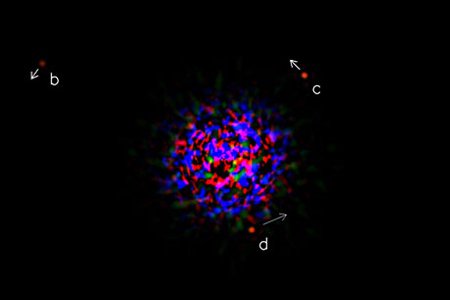
|
HR 8799 is a star with a mass about 1.5 times that of our own Sun, at about 130 light years from the Sun. In November 2008, the 10-meter Keck telescope in Hawaii captured in infrared light three giant planets orbiting this star (a b c on the picture). the planets are at 24, 38, and 68 astronomical units from the star, and the masses are estimated from their luminosity and the system age as between 5 and 13 times that of Jupiter. The 8-meter Gemini North telescope confirmed it by capturing a similar image. Though the three planets are all several times the mass of Jupiter, the discovery show that there are planetary systems with several giant planets located far from the star like ours, with the possibility of Earth-like planets in nearer orbits just like our own system.
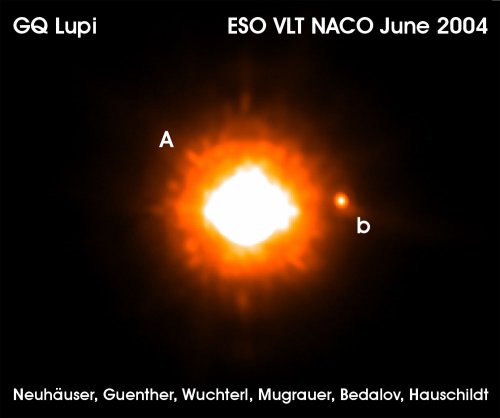
|
Credit: (NACO/VLT) - ESO PR Photo 10a/05 - "The Sub-Stellar Companion to GQ Lupi" - Caption: "ESO PR Photo 10a/05 shows the VLT NACO image, taken in the Ks-band, of GQ Lupi. The feeble point of light to the right of the star is the newly found cold companion. It is 250 times fainter than the star itself and it located 0.73 arcsecond west. At the distance of GQ Lupi, this corresponds to a distance of roughly 100 astronomical units. North is up and East is to the left.
The photograph is the result of a work led by Ralph Neuhaeuser of the Astrophysical Institute and University Observatory (AIU).
The star GQ Lupi is similar to a young version of our Sun, it only about 1 million years old and it has 70% of our sun's mass. It has been observed by a team of European astronomers since 1999. They have made three images using the Very Large Telescope (VLT) of the European Southern Observatory (ESO) in Chile. The Hubble Space Telescope and the Japanese Subaru Telescope each contributed an image, too.
The star GQ Lupi is part of a star-forming region about 400 light-years away.
The planet, then thought to be one to two times as massive as Jupiter, is clearly linked to the star gravitationally: The separation between the star and the planet has not changed from 1999 to 2004, which means that they move together on the sky.
The warmth of the planet, 2000 degrees Kelvin, makes it only 156 times fainter than the star, which made it comparatively easier to see in the glare of its host star compared with more mature planets. Also, the planet is very far from the star, about 100 times the distance between Earth and the Sun, or three times farther from GQ Lupi than Neptune is from our Sun. This was another factor in helping to separate the light between the two objects.
The orbital period of the planet is estimated as roughly 1,200 years gien its distance from the star and masses, so its orbital motion is not yet detected.
However, according to Astro News Brief, a web site by people of the Sky and Telescope magazine, Neuhauser and his colleagues have written a new paper suggesting that the object in question could be as much as 42 Jupiter masses, and in this case it is not by definition a planet but a bwon dwarf star; however I could not confirm this new information yet.
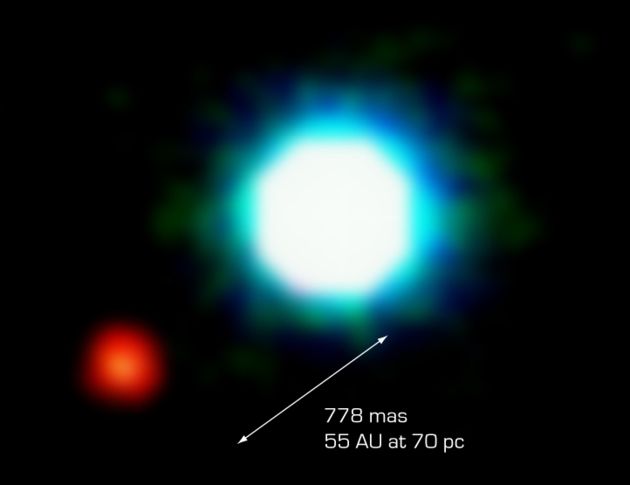
|
Credit: (VLT/NACO) - ESO PR Photo 14a/05 - "The Brown Dwarf 2M1207 and its Planetary Companion" - Caption: "ESO PR Photo 14a/05 The first planet outside of our solar system to be imaged orbits a brown dwarf (centre-right) at a distance that is nearly twice as far as Neptune is from the sun. The photo is based on three near-infrared exposures (in the H, K and L' wavebands) with the NACO adaptive-optics facility at the 8.2-m VLT Yepun telescope at the ESO Paranal Observatory.
A group of European-led astronomers has photographed of what appears to be a dim, red point of light that they think is a young, giant planet something like Jupiter orbiting 2M1207, a failed star known as a brown dwarf, just 8 million years old, 25 times heavier than Jupiter and 42 times less massive than our Sun, located at 230 light-years away.
The object is about five times as massive as Jupiter. An analysis of its emissions found it contains water, which suggests its mass is in the range of planets rather than stars. It is very warm, some 1,000 Celsius.
The object orbits 55 times farther from the brown dwarf than Earth is from the Sun, or roughly twice the Earth-to-Neptune distance. It is catalogued as a planet due to the presence of water, and because of its mass of 5 Jupiters.
The research team was led by ESO's Gael Chauvin and the photograph was made at ESO's Paranal Observatory in Chile with an infrared camera, which records heat rather than visible light.
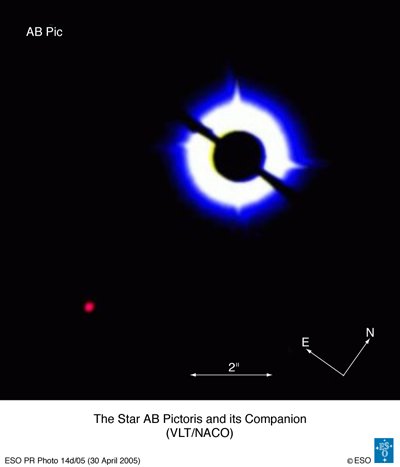
|
Credit: (VLT/NACO) - ESO PR Photo 14d/05 - "The Star AB Pictoris and its Companion" Caption: ESO PR Photo 14d/05 is a coronagraphic image of AB Pictoris showing its tiny companion (bottom left). The data was obtained on 16 March 2003 with NACO on the VLT, using a 1.4 arcsec occulting mask on top of AB Pictoris."
AB Pictoris is likely a sub-brown dwarf companion orbiting its parent star at a distance equivalent to 270 times the distance from the Sun to the Earth very far from its host star, about 9 times further from AB Pictoris than Neptune is from the Sun, and about 150 light years from Earth.
It was imaged for the first time in March 2003, has a near-infrared luminosity and spectrum which points to a light and cool object. Evolutionary model calculations point to a 13 to 14 Jupiter masses object with a temperature of about 1700 Kelvin.
As the presently accepted separation between a high mass planet and a low mass brown dwarf is at 13.6 Jupiter masses, the newly discovered companion thus may lie at the exact boundary between these two classes of sub-stellar objects, planets and brown dwarves.
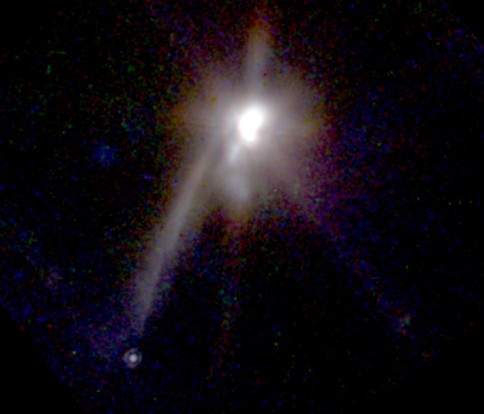
|
This infrared Hubble Space Telescope view might have contained the first ever direct image of a planet outside our own solar system. The picture shows a very young double star located about 450 light-years away toward the constellation of Taurus. Cataloged as TMR-1 (Taurus Molecular Ring star 1), the binary system is still embedded in the dust cloud that formed it. This double star and dust cloud are the brightest grouping in the picture, glowing strongly at infrared wavelengths. A filament extends from the binary system toward the lower left and points toward the spot of light representing the candidate planet. Astronomers believed this planet is a "runaway" object which was gravitationally ejected, the filament tracing the path to its present location at about 1500 times the Earth-Sun distance from the parent star system. Models suggested that the planet and binary system are a mere 300,000 years old, with the planet having a mass of about 2 to 3 Jupiters. While this and other tantalizing discoveries of extrasolar planetary objects and protoplanetary disks don't seem to offer direct examples of solar systems like our own, they do strongly hint that planet formation is a varied and common process.
In mid 2000, the picture was reevaluated and it does indeed not show an exoplanet but a more distant star.